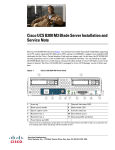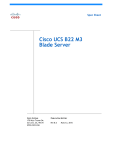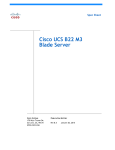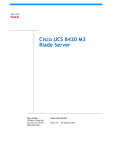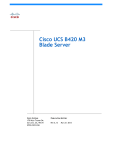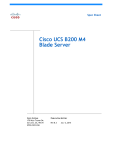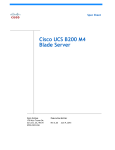Download Cisco UCS B22 M3 Troubleshooting guide
Transcript
Se n d d o c u m e n t c o m m e n t s t o u c s - d o c f e e d b a ck @ c i s c o . c o m Cisco UCS B22 Blade Server Installation and Service Note The UCS B22 M3 blade server (shown in Figure 1) is a half-width blade with 12 DIMM slots;it supports one dedicated slot for Cisco's Virtual Interface Card (VIC) 1240, and one open adapter slot. You may install up to eight UCS B22 Blade Servers to a UCS chassis, or mix with other UCS blade servers. The Cisco UCS B22 M3 Blade Server delivers a balanced price/performance feature set to address quick deployment of scalable IT infrastructure and Web 2.0 applications. Building on the success of the Cisco UCS B-Series Blade Servers, the Cisco UCS B22 M3 Server further extends the capabilities of Cisco's Unified Computing System portfolio in a half-width form factor. The Cisco UCS B22 M3 harnesses the power of the latest Intel® Xeon® processor E5-2400 product family with expandability to 192 GB of RAM (using 12 x 16 GB DIMMs), 2 hot-plug drives, and 2 PCIe adapter slots for up to 80 Gigabit Ethernet throughput. Figure 1 Cisco UCS B22 Front Panel 4 5 1 2 3 6 7 8 9 10 1 Asset tag 1 7 Network link status LED 2 Blade ejector handle 8 Blade health LED 3 Ejector captive screw 9 Console connector Americas Headquarters: Cisco Systems, Inc., 170 West Tasman Drive, San Jose, CA 95134-1706 USA 11 332661 UCS B22 M3 Se n d d o c u m e n t c o m m e n t s t o u c s - d o c f e e d b a ck @ c i s c o . c o m 4 Hard drive bay 1 10 Reset button access 5 Hard drive bay 2 11 Beaconing LED and button 6 Power button and LED 1. Each server has a blank plastic asset tag that pulls out of the front panel, provided so you can add your own asset tracking label without interfering with the intended air flow. LEDs The LED indicators indicate whether the blade server is in active or standby mode, the status of the network link, the overall health of the blade server, and whether the server is set to give a flashing blue beaconing indication. See Table 1 for details. The removable hard disks also have LEDs indicating hard disk access activity and hard disk health. Table 1 Blade Server LEDs LED Color Description Off Power off. Green Normal operation. Amber Standby. Off None of the network links are up. Green At least one network link is up. Off Power off. Green Normal operation. Amber Minor error. Blinking Amber Critical error. Off Beaconing not enabled. Blinking blue 1 Hz Beaconing to locate a selected blade—If the LED is not blinking, the blade is not selected. You can initiate beaconing in UCS Manager or with the button. Activity Off Inactive. (Disk Drive) Green Outstanding I/O to disk drive. Health Off No fault. (Disk Drive) Amber Some fault.1 Power Link Health Beaconing 1. This reading may not be reliable if the drive is part of a damaged RAID array, or if the BIOS fails to complete POST. Buttons The Reset button is just inside the chassis and must be pressed using the tip of a paper clip or a similar item. Hold the button down for five seconds and then release it to restart the server if other methods of restarting are not working. The beaconing function for an individual server may get turned on or off by pressing the combination button and LED. See Table 1 for details. Cisco UCS B22 Blade Server Installation and Service Note 2 OL-27513 -01 Se n d d o c u m e n t c o m m e n t s t o u c s - d o c f e e d b a ck @ c i s c o . c o m The power button and LED allows you to manually take a server temporarily out of service but leave it in a state where it can be restarted quickly. If the desired power state for a service profile associated with a blade server or an integrated rack-mount server is set to "off", using the power button or Cisco UCS Manager to reset the server will cause the desired power state of the server to become out of sync with the actual power state and the server may unexpected shutdown at a later time. To safely reboot a server from a power-down state, use the Boot Server action in Cisco UCS Manager. Connectors A console port is provided to give a direct connection to a blade server to allow operating system installation and other management tasks to be done directly rather than remotely. The port uses the KVM dongle device included in the chassis accessory kit. The KVM cable (N20-BKVM shown in Figure 2) provides a connection into a Cisco UCS blade server, providing a DB9 serial connector, a VGA connector for a monitor, and dual USB ports for a keyboard and mouse. With this cable you can create a direct connection to the operating system and the BIOS running on a blade server. Figure 2 KVM Cable for Blade Servers 4 2 3 192621 1 1 Connector to blade server slot 2 DB9 serial connector 3 VGA connection for a monitor 4 2-port USB connector for a mouse and keyboard Conventions This document uses the following conventions for notes, cautions, and safety warnings. Notes and Cautions contain important information that you should know. Note Means reader take note. Notes contain helpful suggestions or references to material that are not covered in the publication. Caution Means reader be careful. You are capable of doing something that might result in equipment damage or loss of data. Safety warnings appear throughout this publication in procedures that, if performed incorrectly, can cause physical injuries. A warning symbol precedes each warning statement. Cisco UCS B22 Blade Server Installation and Service Note OL-27513 -01 3 Se n d d o c u m e n t c o m m e n t s t o u c s - d o c f e e d b a ck @ c i s c o . c o m Warning IMPORTANT SAFETY INSTRUCTIONS This warning symbol means danger. You are in a situation that could cause bodily injury. Before you work on any equipment, be aware of the hazards involved with electrical circuitry and be familiar with standard practices for preventing accidents. Use the statement number provided at the end of each warning to locate its translation in the translated safety warnings that accompanied this device. Statement 1071 SAVE THESE INSTRUCTIONS Waarschuwing BELANGRIJKE VEILIGHEIDSINSTRUCTIES Dit waarschuwingssymbool betekent gevaar. U verkeert in een situatie die lichamelijk letsel kan veroorzaken. Voordat u aan enige apparatuur gaat werken, dient u zich bewust te zijn van de bij elektrische schakelingen betrokken risico's en dient u op de hoogte te zijn van de standaard praktijken om ongelukken te voorkomen. Gebruik het nummer van de verklaring onderaan de waarschuwing als u een vertaling van de waarschuwing die bij het apparaat wordt geleverd, wilt raadplegen. BEWAAR DEZE INSTRUCTIES Varoitus TÄRKEITÄ TURVALLISUUSOHJEITA Tämä varoitusmerkki merkitsee vaaraa. Tilanne voi aiheuttaa ruumiillisia vammoja. Ennen kuin käsittelet laitteistoa, huomioi sähköpiirien käsittelemiseen liittyvät riskit ja tutustu onnettomuuksien yleisiin ehkäisytapoihin. Turvallisuusvaroitusten käännökset löytyvät laitteen mukana toimitettujen käännettyjen turvallisuusvaroitusten joukosta varoitusten lopussa näkyvien lausuntonumeroiden avulla. SÄILYTÄ NÄMÄ OHJEET Attention IMPORTANTES INFORMATIONS DE SÉCURITÉ Ce symbole d'avertissement indique un danger. Vous vous trouvez dans une situation pouvant entraîner des blessures ou des dommages corporels. Avant de travailler sur un équipement, soyez conscient des dangers liés aux circuits électriques et familiarisez-vous avec les procédures couramment utilisées pour éviter les accidents. Pour prendre connaissance des traductions des avertissements figurant dans les consignes de sécurité traduites qui accompagnent cet appareil, référez-vous au numéro de l'instruction situé à la fin de chaque avertissement. CONSERVEZ CES INFORMATIONS Warnung WICHTIGE SICHERHEITSHINWEISE Dieses Warnsymbol bedeutet Gefahr. Sie befinden sich in einer Situation, die zu Verletzungen führen kann. Machen Sie sich vor der Arbeit mit Geräten mit den Gefahren elektrischer Schaltungen und den üblichen Verfahren zur Vorbeugung vor Unfällen vertraut. Suchen Sie mit der am Ende jeder Warnung angegebenen Anweisungsnummer nach der jeweiligen Übersetzung in den übersetzten Sicherheitshinweisen, die zusammen mit diesem Gerät ausgeliefert wurden. BEWAHREN SIE DIESE HINWEISE GUT AUF. Cisco UCS B22 Blade Server Installation and Service Note 4 OL-27513 -01 Se n d d o c u m e n t c o m m e n t s t o u c s - d o c f e e d b a ck @ c i s c o . c o m Avvertenza IMPORTANTI ISTRUZIONI SULLA SICUREZZA Questo simbolo di avvertenza indica un pericolo. La situazione potrebbe causare infortuni alle persone. Prima di intervenire su qualsiasi apparecchiatura, occorre essere al corrente dei pericoli relativi ai circuiti elettrici e conoscere le procedure standard per la prevenzione di incidenti. Utilizzare il numero di istruzione presente alla fine di ciascuna avvertenza per individuare le traduzioni delle avvertenze riportate in questo documento. CONSERVARE QUESTE ISTRUZIONI Advarsel VIKTIGE SIKKERHETSINSTRUKSJONER Dette advarselssymbolet betyr fare. Du er i en situasjon som kan føre til skade på person. Før du begynner å arbeide med noe av utstyret, må du være oppmerksom på farene forbundet med elektriske kretser, og kjenne til standardprosedyrer for å forhindre ulykker. Bruk nummeret i slutten av hver advarsel for å finne oversettelsen i de oversatte sikkerhetsadvarslene som fulgte med denne enheten. TA VARE PÅ DISSE INSTRUKSJONENE Aviso INSTRUÇÕES IMPORTANTES DE SEGURANÇA Este símbolo de aviso significa perigo. Você está em uma situação que poderá ser causadora de lesões corporais. Antes de iniciar a utilização de qualquer equipamento, tenha conhecimento dos perigos envolvidos no manuseio de circuitos elétricos e familiarize-se com as práticas habituais de prevenção de acidentes. Utilize o número da instrução fornecido ao final de cada aviso para localizar sua tradução nos avisos de segurança traduzidos que acompanham este dispositivo. GUARDE ESTAS INSTRUÇÕES ¡Advertencia! INSTRUCCIONES IMPORTANTES DE SEGURIDAD Este símbolo de aviso indica peligro. Existe riesgo para su integridad física. Antes de manipular cualquier equipo, considere los riesgos de la corriente eléctrica y familiarícese con los procedimientos estándar de prevención de accidentes. Al final de cada advertencia encontrará el número que le ayudará a encontrar el texto traducido en el apartado de traducciones que acompaña a este dispositivo. GUARDE ESTAS INSTRUCCIONES Varning! VIKTIGA SÄKERHETSANVISNINGAR Denna varningssignal signalerar fara. Du befinner dig i en situation som kan leda till personskada. Innan du utför arbete på någon utrustning måste du vara medveten om farorna med elkretsar och känna till vanliga förfaranden för att förebygga olyckor. Använd det nummer som finns i slutet av varje varning för att hitta dess översättning i de översatta säkerhetsvarningar som medföljer denna anordning. SPARA DESSA ANVISNINGAR Cisco UCS B22 Blade Server Installation and Service Note OL-27513 -01 5 Se n d d o c u m e n t c o m m e n t s t o u c s - d o c f e e d b a ck @ c i s c o . c o m Cisco UCS B22 Blade Server Installation and Service Note 6 OL-27513 -01 Se n d d o c u m e n t c o m m e n t s t o u c s - d o c f e e d b a ck @ c i s c o . c o m Aviso INSTRUÇÕES IMPORTANTES DE SEGURANÇA Este símbolo de aviso significa perigo. Você se encontra em uma situação em que há risco de lesões corporais. Antes de trabalhar com qualquer equipamento, esteja ciente dos riscos que envolvem os circuitos elétricos e familiarize-se com as práticas padrão de prevenção de acidentes. Use o número da declaração fornecido ao final de cada aviso para localizar sua tradução nos avisos de segurança traduzidos que acompanham o dispositivo. GUARDE ESTAS INSTRUÇÕES Advarsel VIGTIGE SIKKERHEDSANVISNINGER Dette advarselssymbol betyder fare. Du befinder dig i en situation med risiko for legemesbeskadigelse. Før du begynder arbejde på udstyr, skal du være opmærksom på de involverede risici, der er ved elektriske kredsløb, og du skal sætte dig ind i standardprocedurer til undgåelse af ulykker. Brug erklæringsnummeret efter hver advarsel for at finde oversættelsen i de oversatte advarsler, der fulgte med denne enhed. GEM DISSE ANVISNINGER Cisco UCS B22 Blade Server Installation and Service Note OL-27513 -01 7 Se n d d o c u m e n t c o m m e n t s t o u c s - d o c f e e d b a ck @ c i s c o . c o m Cisco UCS B22 Blade Server Installation and Service Note 8 OL-27513 -01 Installing and Removing a Blade Server Hard Drive Se n d d o c u m e n t c o m m e n t s t o u c s - d o c f e e d b a ck @ c i s c o . c o m Installing and Removing a Blade Server Hard Drive There are up to 2 front-accessible, hot-swappable, 2.5-inch drives per blade. An LSI 2002 RAID controller is embedded in the motherboard (a Cisco exclusive and not separately replaceable) and it supports RAID 0 and 1. You can remove blade server hard drives without removing the blade server from the chassis. All other component replacement for a blade server requires removing the blade from the chassis. Unused hard drive bays should always be covered with cover plates (N20-BBLKD) to assure proper cooling and ventilation. The chassis is omitted from illustrations here to simplify the drawing. Caution Note To prevent ESD damage, wear grounding wrist straps during these procedures and handle modules by the carrier edges only. If you ever need to move a RAID cluster from one server to another, both the old and new servers for the cluster must use the same LSI controller. For example, migration from a server with an LSI 1064E to a server with an LSI MegaRAID is not supported. Migrating a RAID cluster from a B200 M1 or M2 to this server is not supported. Replacing an HDD or SSD with a drive of the same size, model, and manufacturer generally causes few problems with UCS Manager. If the drive being replaced was part of a RAID array we recommend using a newly ordered drive of identical size, model, and manufacturer to replace the failed drive. Cisco recommends following industry standard practice of using drives of the same capacity when creating RAID volumes. If drives of different capacities are used, the useable portion of the smallest drive will be used on all drives that make up the RAID volume. Before upgrading or adding an HDD to a running system, check the service profile in UCS Manager and make sure the new hardware configuration will be within the parameters allowed by the service profile. Hard disk and RAID troubleshooting information is in the "Troubleshooting Server Hardware" chapter of the Cisco UCS Troubleshooting Guide. Cisco UCS B22 Blade Server Installation and Service Note OL-27513 -01 9 Installing and Removing a Blade Server Hard Drive Se n d d o c u m e n t c o m m e n t s t o u c s - d o c f e e d b a ck @ c i s c o . c o m Table 2 shows the drives supported in this blade server. Table 2 Supported Hard Disk Drives (HDD) Product ID HDDs Description A03-D146GC2 146 GB 6 Gb SAS transfer rate, 15 K RPM SFF HDD/hot plug/drive sled mounted UCS-HDD300GI2F105 300 GB 6 Gb SAS transfer rate, 15 K RPM SFF HDD/hot plug/drive sled mounted A03-D300GA2 300 GB 6 Gb SAS transfer rate, 10K RPM SFF HDD/hot plug/drive sled mounted A03-D600GA2 SSDs 600 GB 6 Gb SAS transfer rate, 10 K RPM SFF HDD/hot plug/drive sled mounted UCS-SD100G0KA2-E 100 GB Std Height 15 mm SATA SSD hot plug/drive sled mounted Removing a Blade Server Hard Drive To remove a hard drive from a blade server, follow these steps: Step 1 Push the button to release the ejector, and then pull the hard drive from its slot. Figure 3 Removing the Hard Drive 3 331362 2 1 Step 2 Place the hard drive on an antistatic mat or antistatic foam if you are not immediately reinstalling it in another blade server. Step 3 Install a blank faceplate (UCS-HD-BBLKD) to keep dust out of the blade server if the slot will remain empty. Cisco UCS B22 Blade Server Installation and Service Note 10 OL-27513 -01 Removing and Installing a UCS B22 Blade Server Se n d d o c u m e n t c o m m e n t s t o u c s - d o c f e e d b a ck @ c i s c o . c o m Installing a Blade Server Hard Drive To install a blade server hard drive in a blade server, follow these steps: Step 1 Place the hard drive lever into the open position by pushing the release button (see Figure 4). Installing a Hard Drive in a Blade Server 331363 Figure 4 2 1 Step 2 Gently slide the hard drive into the opening in the blade server until it seats into place. Step 3 Push the hard drive lever into the closed position. You can use UCS Manager to format and configure RAID services. refer to the UCS Manager configuration guide for your software release for details on RAID configuration. If you need to move a RAID cluster, refer to the Moving a RAID Cluster section of the "Troubleshooting Server Hardware" chapter of the Cisco UCS Troubleshooting Guide. Removing and Installing a UCS B22 Blade Server Before performing any internal operation on a blade server, you must remove it from the chassis. To prevent ESD damage, wear grounding wrist straps during these procedures and handle modules by the carrier edges only. Caution To prevent ESD damage, wear grounding wrist straps during these procedures and handle modules by the carrier edges only. Cisco UCS B22 Blade Server Installation and Service Note OL-27513 -01 11 Removing and Installing a UCS B22 Blade Server Se n d d o c u m e n t c o m m e n t s t o u c s - d o c f e e d b a ck @ c i s c o . c o m Shutting Down and Powering Off A Blade Server The server can run in two power modes: • Main power mode—Power is supplied to all server components and any operating system on your hard drives can run. • Standby power mode—Power is supplied only to the service processor and the cooling fans and it is safe to power off the server from this mode. After establishing a connection to the blade server’s operating system, you can directly shut down the blade server using the operating system. You can invoke a graceful shutdown or an emergency shutdown (hard shutdown) by using either of the following methods: Step 1 Step 2 Caution Step 3 • Use the UCS Manager. See either the Cisco UCS Manager GUI Configuration Guide or the Cisco UCS Manager CLI Configuration Guide. • Use the Power button on the server front panel. To use the Power button, follow these steps: Check the color of the Power Status LED. • Green indicates that the server is in main power mode and must be shut down before it can be safely powered off. Go to Step 2. • Amber indicates that the server is already in standby mode and can be safely powered off. Go to Step 3. Invoke either a graceful shutdown or a hard shutdown: To avoid data loss or damage to your operating system, you should always invoke a graceful shutdown of the operating system. • Graceful shutdown—Press and release the Power button. The operating system will perform a graceful shutdown and the server goes to standby mode, which is indicated by an amber Power Status LED. • Emergency shutdown—Press and hold the Power button for 4 seconds to force the main power off and immediately enter standby mode. If you are shutting down all blade servers in a chassis, you should now disconnect the power cords from the chassis to completely power off the servers. If you are only shutting down one server, you can skip unplugging the chassis and move to removing the server. Removing a Cisco UCS B22 Blade Server Figure 5 shows the positioning of a blade server in the chassis. Blade servers reside within the eight upper slots of the chassis. Using UCS Manager, decommission the server using UCS Manager before physically removing the server. To remove a blade server from the chassis, follow these steps: Step 1 Loosen the captive screw on the front of the blade. Step 2 Remove the blade from the chassis by pulling the ejector lever on the blade until it unseats the blade server. Cisco UCS B22 Blade Server Installation and Service Note 12 OL-27513 -01 Removing and Installing a UCS B22 Blade Server Se n d d o c u m e n t c o m m e n t s t o u c s - d o c f e e d b a ck @ c i s c o . c o m Step 3 Slide the blade part of the way out of the chassis, and place your other hand under the blade to support its weight. Step 4 Once removed, place the blade on an antistatic mat or antistatic foam if you are not immediately reinstalling it into another slot. Step 5 If the slot is to remain empty, install a blank faceplate (N20-CBLKB1) to keep dust out of the chassis. Installing a Cisco UCS B22 Blade Server Figure 5 shows the positioning of a blade server in the chassis. Blade servers reside within the eight upper slots of the chassis. To install a blade server, follow these steps: Step 1 Grasp the front of the blade server and place your other hand under the blade to support it. See Figure 5. Positioning a Blade Server in the Chassis 331364 Figure 5 Step 2 Open the ejector lever in the front of the blade server. Step 3 Gently slide the blade into the opening until you cannot push it any farther. Cisco UCS B22 Blade Server Installation and Service Note OL-27513 -01 13 Secure Digital (SD) Card Access Se n d d o c u m e n t c o m m e n t s t o u c s - d o c f e e d b a ck @ c i s c o . c o m Step 4 Press the ejector lever so that it catches the edge of the chassis and presses the blade server all the way in. Step 5 Tighten the captive screw on the front of the blade to no more than 3 in-lbs. Tightening with bare fingers only is unlikely to lead to stripped or damaged captive screws. Step 6 Power on the server. UCS Manager will automatically re acknowledge, reassociate, and recommission the server, provided any hardware changes are allowed by the service profile. Secure Digital (SD) Card Access SD card slots are provided for future usage. Their use is not supported at product release. They will require a future software update to be used. SD Card Slot Locations 332219 Figure 6 Removing a Blade Server Cover Replacing the cover is the reverse of removing the cover. To open a blade server: Step 1 Press and hold the button down as shown in Figure 7 Step 2 While holding the back end of the cover, pull the cover up and back. Cisco UCS B22 Blade Server Installation and Service Note 14 OL-27513 -01 Removing a Blade Server Cover Se n d d o c u m e n t c o m m e n t s t o u c s - d o c f e e d b a ck @ c i s c o . c o m Figure 7 Opening a Cisco UCS B22 Blade Server 331365 2 1 Cisco UCS B22 Blade Server Installation and Service Note OL-27513 -01 15 Removing a Blade Server Cover Se n d d o c u m e n t c o m m e n t s t o u c s - d o c f e e d b a ck @ c i s c o . c o m Air Baffles The air baffles (UCSB-BAFF-B22-M3=) shown in Figure 8 ship with this server, as they direct and improve air flow for the server components. No tools are necessary to install them, just place them over the DIMMs as shown, aligned to the standoffs. Cisco UCS B22 Air Baffles 333340 Figure 8 Cisco UCS B22 Blade Server Installation and Service Note 16 OL-27513 -01 Removing a Blade Server Cover Se n d d o c u m e n t c o m m e n t s t o u c s - d o c f e e d b a ck @ c i s c o . c o m Internal Components Figure 9 calls out the various components within the blade server. Figure 9 Inside View of a Blade Server 1 2 3 4 5 6 7 8 9 10 F0 F1 G0 G1 H0 H1 CPU 1 CPU 2 D1 D0 C1 C0 332662 B1 B0 1 Hard drive bays 2 Internal USB connector 1 3 Battery 4 CPU 1 and heat sink 5 DIMM slots 6 Diagnostic button 7 DIMM slots 8 CPU 2 and heat sink 9 Modular LOM (shown installed) 10 Adapter card connector (Adapter not shown installed) 1. Cisco UCS-USBFLSH-S-4GB= is recommended, but if another USB drive will be used it must be no wider than .8 inches, and no more than 1.345 inches long in order tp provide needed clearances to install or remove the USB drive. Note Use of this server may require an upgrade to the IOM in the chassis. This server only supports third generation adapter cards, which have features requiring a Cisco 2204 or 2208 IOM, and are not backward compatible with the Cisco 2104 IOM. Diagnostics Button and LEDs At blade start-up, POST diagnostics test the CPUs, DIMMs, HDDs and adapter cards, and any failure notifications are sent to UCS Manager. You can view these notifications in the System Error Log or in the output of the show tech-support command. If errors are found, an amber diagnostic LED will also light up next to the failed component. During run time, the blade BIOS, component drivers, and OS all monitor for hardware faults and will light up the amber diagnostic LED for a component if an uncorrectable error or correctable errors (such as a host ECC error) over the allowed threshold occur. LED states are saved, and if you remove the blade from the chassis the LED values will persist for up to 10 minutes. Pressing the LED diagnostics button on the motherboard will cause the LEDs that currently show a component fault to light for up to 30 seconds for easier component identification. LED fault values are reset when the blade is reinserted into the chassis and booted, and the process begins from its start. Cisco UCS B22 Blade Server Installation and Service Note OL-27513 -01 17 Removing a Blade Server Cover Se n d d o c u m e n t c o m m e n t s t o u c s - d o c f e e d b a ck @ c i s c o . c o m If DIMM insertion errors are detected, they may cause the blade discovery to fail and errors will be reported in the server POST information, viewable using the UCS Manager GUI or CLI. UCS blade servers require specific rules to be followed when populating DIMMs in a blade server, and the rules depend on the blade server model. Refer to the documentation for a specific blade server for those rules. HDD status LEDs are on the front face of the HDD. Faults on the CPU, DIMMs, or adapter cards will also cause the server health LED to light solid Amber for minor error conditions or blinking Amber for critical error conditions. Installing a Motherboard CMOS Battery The Cisco B22 blade server supports the following battery: Warning Supported Components Part Number CR2032 battery N20-MBLIBATT There is danger of explosion if the battery is replaced incorrectly. Replace the battery only with the same or equivalent type recommended by the manufacturer. Dispose of used batteries according to the manufacturer’s instructions. Statement 1015 To install or replace a motherboard complementary metal-oxide semiconductor (CMOS) battery, follow these steps: Step 1 Step 2 Remove a motherboard CMOS battery: a. Power off the blade, remove it from the chassis, and remove the top cover as described in the “Removing a Blade Server Cover” section on page 14. b. Press the battery socket retaining clip toward the chassis wall (see Figure 10). c. Lift the battery from the socket. Use needle-nose pliers to grasp the battery if there is not enough clearance for your fingers. Install a motherboard CMOS battery: a. Press the battery socket retaining clip toward the chassis wall. b. Insert the new battery into the socket with the battery’s negative (–) marking toward the chassis wall. Ensure that the retaining clip clicks over the top of the battery. c. Replace the top cover. d. Replace the server in the chassis and power on the blade by pressing the Power button. Cisco UCS B22 Blade Server Installation and Service Note 18 OL-27513 -01 Removing a Blade Server Cover Se n d d o c u m e n t c o m m e n t s t o u c s - d o c f e e d b a ck @ c i s c o . c o m Figure 10 Removing and Replacing a Motherboard CMOS Battery + 333339 CPU 1 CPU Replacement You can order your blade server with two CPUs, or upgrade later to a second CPU. Both CPUs must be of the same type, and memory in slots intended for the second CPU will not be recognized if the second CPU is not present (see Memory Arrangement). You may need to use these procedures to move a CPU from one server to another, or to replace a faulty CPU. Table 3 shows the available CPU options: Table 3 CPU Options Product ID Power Draw (W) DDR3 (MHz) Cores Clock Speed (GHz) Cache (MB) UCS-CPU-E5-2470 / Intel E5-2470 95W 1600 8 2.30 20 UCS-CPU-E5-2450 / Intel E5-2450 95W 1600 8 2.10 20 UCS-CPU-E5-2440 / Intel E5-2440 95W 1333 6 2.40 15 UCS-CPU-E5-2430L / Intel E5-2430L 60W 1333 6 2.00 15 UCS-CPU-E5-2420 / Intel E5-2420 95W 1333 6 1.90 15 UCS-CPU-E5-2403 / Intel E5-2403 80W 1066 4 1.80 10 Cisco UCS B22 Blade Server Installation and Service Note OL-27513 -01 19 Removing a Blade Server Cover Se n d d o c u m e n t c o m m e n t s t o u c s - d o c f e e d b a ck @ c i s c o . c o m Removing a CPU and Heat Sink To remove a CPU and heat sink, follow these steps: Step 1 Unscrew the four captive screws securing the heat sink to the motherboard. See Figure 11, callout 1. Step 2 Remove the heat sink (N20-BHTS1=). See Figure 11, callout 2. Remove the old thermal compound from the bottom of the heat sink using the cleaning kit (UCSX-HSCK= ) available from Cisco. Follow the instructions on the two bottles of cleaning solvent. Step 3 Unhook the socket latch. See Figure 11, callout 3. Step 4 Open the socket latch. See Figure 11, callout 4. Step 5 Remove the old CPU as follows: a. Note Place the CPU alignment tool (UCS-CPU-EN-PNP=) on the CPU bezel aligned with the A1 arrow pointing to the CPU registration mark as shown in Figure 13. The CPU alignment tool is included with each CPU option kit. b. Press the side lever on the tool to grasp the installed CPU. c. Lift the tool and CPU straight up. Figure 11 Removing The Heat Sink and Accessing the CPU Socket 1 2 1 1 1 3 332667 4 Cisco UCS B22 Blade Server Installation and Service Note 20 OL-27513 -01 Removing a Blade Server Cover Se n d d o c u m e n t c o m m e n t s t o u c s - d o c f e e d b a ck @ c i s c o . c o m Installing a CPU and Heat Sink Before installing a new CPU in a server, verify the following: • The CPU is supported for that model server. • A BIOS is available and installed that supports the CPU/DIMM and server combination. • The service profile for this server in UCS Manager will recognize and allow the new CPU. This is especially important if you have been using a single processor and install a second processor. To install a CPU and heat sink, follow these steps: Step 1 Prime the alignment tool (UCS-CPU-EN-PNP=) by pressing the central button. Step 2 Remove the new CPU from the packaging, and place it into the alignment tool as shown in Figure 12 . Only touch the CPU by the edges. Loading the Alignment Tool 331371 Figure 12 Cisco UCS B22 Blade Server Installation and Service Note OL-27513 -01 21 Removing a Blade Server Cover Se n d d o c u m e n t c o m m e n t s t o u c s - d o c f e e d b a ck @ c i s c o . c o m Step 3 Place the alignment tool with a CPU loaded on the base aligned as shown in Figure 13. Figure 13 Proper Alignment and CPU Insertion Side lever Central button 332668 Alignment mark Step 4 Press the central button on the alignment tool to release the CPU into the socket. Cisco UCS B22 Blade Server Installation and Service Note 22 OL-27513 -01 Removing a Blade Server Cover Se n d d o c u m e n t c o m m e n t s t o u c s - d o c f e e d b a ck @ c i s c o . c o m Figure 14 Replacing the Heat Sink 4 3 C 4 B A 4 D 4 1 332669 2 Step 5 Close the socket latch. See Figure 14, callout 1. Step 6 Lock the socket latch into place with the hook. See Figure 14, callout 2. Step 7 Using the tube of thermal compound (UCS-CPU-GREASE=) provided with replacement CPUs and servers (Dow-Corning TC-1996, Intel D54816-0 or an equivalent may also be used), add a protective film of thermal compound to the bottom of the heat sink (UCSB-HS-01-B22=) where it will contact the CPU. Step 8 Replace the heat sink. See Figure 14, callout 3. Caution For proper cooling, align the arrows on the installed heat sink to point to the front and back of the blade. Make sure that the heat sink fins are aligned to run along the length of the blade server (see Figure 14). Step 9 Secure the heat sink to the motherboard by tightening the four captive screws. See Figure 14, callout 4. Be sure to tighten in the order shown in Figure 14. Cisco UCS B22 Blade Server Installation and Service Note OL-27513 -01 23 Removing a Blade Server Cover Se n d d o c u m e n t c o m m e n t s t o u c s - d o c f e e d b a ck @ c i s c o . c o m Installing Memory To install a DIMM into the B22 blade server, follow these steps: Step 1 Open both DIMM connector latches. Figure 15 Installing DIMMs in the Blade Server 1 2 3 332666 2 1 3 Step 2 Note Step 3 Press the DIMM into its slot evenly on both ends until it clicks into place. Be sure that the notch in the DIMM aligns with the slot. If the notch is misaligned you may damage the DIMM, the slot, or both. Press the DIMM connector latches inward slightly to seat them fully. Supported DIMMs The following table lists the type of DIMMs that Cisco makes available for use with this blade server: Table 4 Cisco Supported DIMMs for B22 M3 Servers Cisco Product ID Description UCS-MR-1X162RY-A 16 GB DDR3 1600 MHz RDIMM PC3-12800 dual rank/Low Voltage UCS-MR-1X082RY-A 8 GB DDR3 1600 MHz RDIMM PC3-12800 dual rank/Low Voltage UCS-MR-1X041RY-A 4 GB DDR3 1600 MHz RDIMM PC3-12800 single rank/1.35v/1.5v Cisco UCS B22 Blade Server Installation and Service Note 24 OL-27513 -01 Removing a Blade Server Cover Se n d d o c u m e n t c o m m e n t s t o u c s - d o c f e e d b a ck @ c i s c o . c o m Low-Voltage DIMM Considerations The server can be ordered with low-voltage (1.35 V) DIMMs or mixed-voltage (1.35V/1.5 V) DIMMs. There is a setting in the BIOS Setup utility that you can use to change the DDR memory mode when the server has all low-voltage DIMMs installed. To access this setting, follow these steps: Step 1 Enter the BIOS setup utility by pressing the F2 key when prompted during bootup. Step 2 Select the Advanced tab. Step 3 Select Low Voltage DDR Mode. Step 4 In the pop-up window, select either Power Saving Mode or Performance Mode. Step 5 • Power Saving Mode–Enables low-voltage memory operation. This setting is available only if all DIMMs installed support low-voltage operation. • Performance Mode–Disables low-voltage memory operation. If you mix low-voltage DIMMs with mixed-voltage DIMMs, the system defaults to this setting. Press F10 to save your changes and exit the setup utility, or you can exit without saving changes by pressing Esc. Memory Arrangement Keep in mind the following rules when adding DIMMs to this server: • Only use Cisco-provided DIMMs. • Mixing different speed DIMMs causes the server to set the memory speed to that of the slowest installed DIMMs. • If memory mirroring is used, the total memory capacity is reduced by 50%. • CPU1 and CPU2 (if used) must always be configured identically. Cisco UCS B22 Blade Server Installation and Service Note OL-27513 -01 25 Removing a Blade Server Cover Se n d d o c u m e n t c o m m e n t s t o u c s - d o c f e e d b a ck @ c i s c o . c o m The blade server contains 12 DIMM slots—six for each CPU. Each set of six DIMM slots is arranged into three channels, where each channel has 2 DIMMs (see Figure 16). Each channel is identified by a letter—B, C, D for CPU1, and F, G, H for CPU 2. Each DIMM slot is identified by a number, either 0 or 1. Note that each DIMM slot 0 is blue, while each slot 1 is black. Figure 16 shows how DIMMs and channels are physically laid out on the blade server. The DIMM slots in the upper right are associated with CPU 2, while the DIMM slots in the lower left are associated with CPU 1. Figure 16 Numbering of DIMMs and Channels F0 F1 G0 G1 H0 H1 CPU 1 CPU 2 D1 D0 C1 B1 B0 Note 332664 C0 The memory in the upper right cannot communicate with the memory in lower left, unless both CPUs are present. Cisco UCS B22 Blade Server Installation and Service Note 26 OL-27513 -01 Removing a Blade Server Cover Se n d d o c u m e n t c o m m e n t s t o u c s - d o c f e e d b a ck @ c i s c o . c o m Figure 17 shows a logical view of the DIMMs and Channels Channel E Channel F 333341 G1 Bank 2 F1 Channel D H1 F0 G0 H0 C0 B1 B0 CPU 2 CPU 1 D0 Channel C C1 Channel B D1 Channel A Bank 1 Logical Representation of Logical DIMMs and Channels Bank 2 Bank 1 Figure 17 DIMMs can be used in the blade server in either a one DIMM per Channel (1DPC) configuration or in a two DIMMs per Channel (2DPC) configuration. Each CPU in a Cisco UCS B22 blade server supports 3 channels of 2 memory slots each. In a 1 DPC configuration, DIMMs are in slot 0 only. In a 2 DPC configuration, DIMMs are in both slot 0 and slot 1. Table 5 shows the preferred order for installing upgrade DIMMs, and while other configurations may work if problems arise moving them to the preferred arrangement should help. Table 5 Preferred DIMM Population Order DIMMs per CPU CPU 1 installed slots CPU 2 installed slots 1 B0 F0 2 B0, C0 F0, G0 3 B0, C0, D0 F0, G0, H0 4 B0, C0, D0, B1 F0, G0, H0, F1 5 B0, C0, D0, B1, C1 F0, G0, H0, F1, G1 6 B0, C0, D0, B1, C1, D1 F0, G0, H0, F1, G1, H1 Memory Performance When considering the memory configuration of your blade server, there are several things you need to consider. For example: • DIMMs within the blade server should be configured in complete banks for optimal performance. • Your selected CPU(s) can have some affect on performance. Cisco UCS B22 Blade Server Installation and Service Note OL-27513 -01 27 Removing a Blade Server Cover Se n d d o c u m e n t c o m m e n t s t o u c s - d o c f e e d b a ck @ c i s c o . c o m Bandwidth and Performance Recommendations for achieving performance of 1600 MHz on B22 M3 servers: • Ensure that both the installed CPU and the selected DIMMs support operation at 1600 MHz. If either cannot support this, the pair will run at the highest speeed of the slower of the two. • Ensure the server is running the 2.0(2) or later BIOS version. If a BIOS upgrade is needed, do it before installing processors or memory. • Use only Cisco certified DIMMs that support 1600 MHz speeds (see Table 3). DIMMs do not have to be identical in type or capacity, but beware of the caveats listed in the section below regarding performance degradation. • Always set the system BIOS to operate the DIMMs in "Performance" mode in order to run at 1600 MHz. • Fully populating 1 logical bank or 2 logical banks with DIMMs will ensure optimal memory bandwidth running at the 1600 MHz speed. If DIMMs are partially populated in 1 bank (less than 6 DIMMs) or 2 bank patterns (less than 12 but greater than 6 DIMMs) the 1600 MHz speed can be used, but the overall memory bandwidth will not be optimal. Performance Degradation Performance degradation can occur if the following memory configurations are used: • Mixing DIMM sizes and densities within a channel • Partially populating a channel • Unevenly populating DIMMs between CPUs Memory Mirroring and RAS The Intel CPUs within the blade server support memory mirroring only when no more than two Channels are populated with DIMMs. If three Channels are populated with DIMMs, memory mirroring is automatically disabled. Furthermore, if memory mirroring is used, DRAM size is reduced by 50% for reasons of reliability. If the RAS (Reliability, Availability, and Serviceability) option is required, it is available only when Channel–3 is not populated. Installing a Modular LOM The modular LOM is a specialized I/O adapter providing 2 x 10 Gigabit of Ethernet/FCoE connectivity to each chassis IOM. The following option is available: Table 6 Modular LOM Options Cisco Product ID Name UCSB-MLOM-40G-01 Cisco VIC 1240 - 40 Gb mLOM for UCS M3 Blade Servers. Plugs into the dedicated mLOM connector only. It is the only card that can be plugged into the mLOM connector. Cisco UCS B22 Blade Server Installation and Service Note 28 OL-27513 -01 Removing a Blade Server Cover Se n d d o c u m e n t c o m m e n t s t o u c s - d o c f e e d b a ck @ c i s c o . c o m Note You must remove the adapter card to service the modular LOM. To install a modular LOM card on the blade server, follow these steps: Step 1 Position the modular LOM’s board connector above the motherboard connector and align the captive screw to the standoff post on the motherboard. Step 2 Firmly press the modular LOM’s board connector into the motherboard connector. Step 3 Tighten the captive screw. Tip Removing a modular LOM is the reverse of installing it. You may find it helpful when removing the connector from the motherboard to gently rock the board along the length of the connector until it loosens. Figure 18 Installing a Modular LOM 3 2 332218 1 Cisco UCS B22 Blade Server Installation and Service Note OL-27513 -01 29 Removing a Blade Server Cover Se n d d o c u m e n t c o m m e n t s t o u c s - d o c f e e d b a ck @ c i s c o . c o m Installing an Adapter Card The network adapters and interface cards all have a shared installation process. The following options are available: Table 7 Note Adapter Card Options Cisco Product ID Name UCS-VIC-M82-8P VIC 1280 - Dual 40Gb capable Virtual Interface Card Use of this server may require an upgrade to the IOM in the chassis. This server only supports third generation adapter cards, which have features requiring a Cisco 2204 or 2208 IOM, and are not backward compatible with the Cisco 2104 IOM. If you are switching from one type of adapter card to another, before you physically perform the switch make sure that you have downloaded the latest device drivers and loaded them into the server’s operating system. For more information, refer to the firmware management chapter of one of the UCS Manager software configuration guides. To install an adapter card on the blade server, follow these steps: Step 1 Position the adapter board connector above the motherboard connector and align the two adapter captive screws to the standoff posts on the motherboard. Step 2 Firmly press the adapter connector into the motherboard connector. Step 3 Tighten the two captive screws. Tip Removing an adapter card is the reverse of installing it. You may find it helpful when removing the connector from the motherboard to gently rock the board along the length of the connector until it loosens. Cisco UCS B22 Blade Server Installation and Service Note 30 OL-27513 -01 Trusted Platform Module Se n d d o c u m e n t c o m m e n t s t o u c s - d o c f e e d b a ck @ c i s c o . c o m Figure 19 Installing an Adapter Card 3 2 1 331730 1 Trusted Platform Module The Trusted Platform Module (TPM, Cisco Product ID UCSX-TPM1-001) is a component that can securely store artifacts used to authenticate the server. These artifacts can include passwords, certificates, or encryption keys. A TPM can also be used to store platform measurements that help ensure that the platform remains trustworthy. Authentication (ensuring that the platform can prove that it is what it claims to be) and attestation (a process helping to prove that a platform is trustworthy and has not been breached) are necessary steps to ensure safer computing in all environments. TPM is a factory-configurable option for this server. It is a requirement for the Intel Trusted Execution Technology (TXT) security feature, which must be enabled in the BIOS settings for a server equipped with a TPM. A TPM can not be added later by customers, or moved from one server to another. To enable the TPM: Step 1 Enable Quiet Mode in the BIOS policy of the server’s Service Profile. Step 2 Establish a direct connection to the server, either by connecting a keyboard, monitor, and mouse to the front panel using a KVM dongle (N20-BKVM shown in Figure 2) or by other means. Step 3 Reboot the server. Press F2 during reboot to enter the BIOS setup screens. Cisco UCS B22 Blade Server Installation and Service Note OL-27513 -01 31 Server Troubleshooting Se n d d o c u m e n t c o m m e n t s t o u c s - d o c f e e d b a ck @ c i s c o . c o m Step 4 On the Advanced tab, select Trusted Computing and press Enter. Step 5 Set the TPM Support optionto Enable. Step 6 Press F10 to save and exit. Allow the server to finish booting. Server Troubleshooting For general server troubleshooting information, refer to the "Troubleshooting Server Hardware" chapter of the Cisco UCS Troubleshooting Guide. Server Configuration UCS servers are intended to be configured and managed using UCS Manager. Refer to the UCS Manager Configuration Guide appropriate for your UCS Manager version Server Specifications Table 8 Physical Specifications for the Cisco UCS B22 Blade Server Specification Value Height 1.95 inches (50 mm) Width 8.00 inches (203 mm) Depth 24.4 inches (620 mm) Weight 13.5 lbs (6.1 kg) 1 1. The system weight listed here is an estimate for a fully configured system and will vary depending on peripheral devices installed. Related Documentation The documentation set for the Cisco Unified Computing System environment is described in full at: http://www.cisco.com/go/unifiedcomputing/b-series-doc Obtaining Documentation and Submitting a Service Request For information on obtaining documentation, submitting a service request, and gathering additional information, see the monthly What’s New in Cisco Product Documentation, which also lists all new and revised Cisco technical documentation, at: http://www.cisco.com/en/US/docs/general/whatsnew/whatsnew.html Cisco UCS B22 Blade Server Installation and Service Note 32 OL-27513 -01 Related Documentation Se n d d o c u m e n t c o m m e n t s t o u c s - d o c f e e d b a ck @ c i s c o . c o m Subscribe to the What’s New in Cisco Product Documentation as an RSS feed and set content to be delivered directly to your desktop using a reader application. The RSS feeds are a free service. Cisco currently supports RSS Version 2.0. Cisco and the Cisco logo are trademarks or registered trademarks of Cisco and/or its affiliates in the U.S. and other countries. To view a list of Cisco trademarks, go to this URL: www.cisco.com/go/trademarks. Third-party trademarks mentioned are the property of their respective owners. The use of the word partner does not imply a partnership relationship between Cisco and any other company. (1110R) Any Internet Protocol (IP) addresses and phone numbers used in this document are not intended to be actual addresses and phone numbers. Any examples, command display output, network topology diagrams, and other figures included in the document are shown for illustrative purposes only. Any use of actual IP addresses or phone numbers in illustrative content is unintentional and coincidental. © 2012 Cisco Systems, Inc. All rights reserved. Cisco UCS B22 Blade Server Installation and Service Note OL-27513 -01 33 Related Documentation Se n d d o c u m e n t c o m m e n t s t o u c s - d o c f e e d b a ck @ c i s c o . c o m Cisco UCS B22 Blade Server Installation and Service Note 34 OL-27513 -01


































